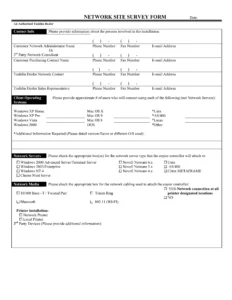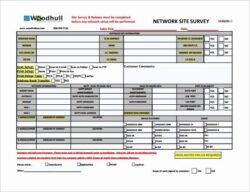Embarking on any significant IT project, whether it’s setting up a new office, relocating existing infrastructure, or upgrading your network, always starts with a critical first step: the site survey. It’s not just about walking around with a clipboard; it’s a deep dive into the physical environment where your technology will live. This crucial preliminary phase ensures that everything from power outlets to network connectivity, and even environmental factors like temperature and humidity, are meticulously documented and accounted for. Skipping this step is akin to building a house without checking the foundation – you’re just inviting trouble down the line.
You might think, “Can’t I just wing it?” and while small, simple setups might sometimes get away with a less formal approach, any complex IT deployment truly benefits from a structured methodology. This is precisely where an effective information technology site survey template comes into play. It acts as your comprehensive checklist, ensuring no stone is left unturned and no critical detail is overlooked. It brings consistency to your data collection, making sure every relevant piece of information is gathered efficiently, paving the way for smoother project execution and avoiding costly surprises.
Why a Robust IT Site Survey is Non-Negotiable for Project Success
When you’re planning any IT infrastructure deployment or upgrade, the physical environment often presents hidden challenges that can derail timelines and blow budgets. Imagine deploying a new server rack only to find out there isn’t enough power, or installing Wi-Fi access points in a building with thick concrete walls that block signals. These are common scenarios that a thorough IT site survey is designed to prevent. It’s about understanding the existing conditions, identifying potential obstacles, and gathering all the necessary data to design an efficient and effective solution that truly fits the space.
A well-structured survey goes beyond just checking boxes; it’s a proactive risk mitigation strategy. By identifying constraints like limited space, inadequate cooling, or outdated cabling infrastructure early on, you can address them in the planning phase rather than scrambling during deployment. This foresight saves countless hours of troubleshooting, avoids expensive rework, and ultimately ensures your project stays on track and within budget. It provides the foundational data needed for accurate equipment procurement, resource allocation, and realistic timeline estimations.
Think of the site survey as gathering intelligence. You’re collecting vital information on every aspect of the physical location that could impact your IT systems. This includes environmental factors, existing network infrastructure, power availability, physical security considerations, and even accessibility for future maintenance. A detailed assessment allows you to tailor your design to the unique characteristics of the site, preventing common pitfalls and ensuring optimal performance of your new or upgraded systems.
To give you a clearer picture, here are some critical components you’d typically scrutinize to ensure comprehensive coverage:
Key Areas to Cover in Your Survey
- **Power infrastructure:** Are there enough outlets? What’s the voltage? Is there UPS or generator backup capacity available, and is it sufficient for new loads?
- **Network cabling:** What existing cabling is in place (e.g., Cat5e, Cat6, fiber)? Is it adequately labeled and terminated? Are there enough network drops for projected needs?
- **Wireless coverage:** Are there dead spots or areas with weak signals? What are the building materials like (e.g., concrete, drywall, metal), and how might they impact signal propagation? What potential interference sources exist?
- **Environmental conditions:** Document current temperature, humidity levels, airflow patterns, and any visible dust or debris. Are there existing HVAC systems, and can they support additional heat loads?
- **Physical security:** Assess current access control measures, potential CCTV placement for monitoring, and the overall security of server rooms or critical IT closets.
- **Space and layout:** Measure available rack space, floor space for new equipment, suitable pathways for conduit, and accessibility to ceiling plenums for cabling.
- **Existing equipment inventory:** List all current hardware that needs to be accounted for, integrated, or potentially removed during the project.
Having a clear, structured approach for documenting these areas is what truly makes an information technology site survey template an invaluable asset. It standardizes your data collection, making comparisons between sites or phases of a project much easier and more reliable, and ensuring nothing slips through the cracks.
Crafting Your Own IT Site Survey Template: Essential Elements to Include
Developing or customizing your own information technology site survey template is a process of refinement, but there are core elements that every good template should feature. It’s not just a blank form; it’s a living document that evolves with your projects and organizational needs. Start by breaking down your survey into logical sections, ensuring that each area of assessment has its dedicated space for notes, measurements, and observations. This structure helps guide the surveyor through a comprehensive data collection process, minimizing the chance of missing critical details.
Beyond the basics like site address and primary contact information, consider dedicated sections for each domain of your IT infrastructure. For instance, a section for “Network Connectivity” might include fields for existing ISP details, current router models, switch counts, and the specific type of cabling discovered. A “Power and Environmental” section would cover electrical panel locations, available amperage per circuit, details on existing HVAC systems, and even specifics on fire suppression systems. Remember, the more granular and specific your template is, the more useful the collected data will be for your design and implementation teams.
Don’t forget the importance of visual documentation. Integrate spaces within your template for photo references, perhaps even a checklist for ensuring key areas are photographed. A picture is worth a thousand words, especially when describing a unique cabling run, illustrating a challenging physical layout, or showing a tight space where new equipment needs to be installed. Also, ensure there are clear sections for initial recommendations and identified risks. This allows the surveyor to not just collect data but also to flag potential issues and suggest preliminary solutions directly within the survey document.
Finally, make sure your template includes a sign-off section, possibly by the site contact or client representative, confirming that the information gathered is accurate to their knowledge. This adds a layer of accountability and ensures everyone is on the same page regarding the existing site conditions. Regularly review and update your template based on lessons learned from previous projects. Ask yourself: What worked well? What critical information was consistently missing? What could be clearer or more detailed? This iterative process ensures your template remains a relevant and powerful tool in your project management arsenal, adapting to new technologies and evolving business requirements.
Ultimately, investing time in a meticulous site survey, guided by a well-designed template, dramatically improves the success rate of any IT project. It’s the cornerstone of effective planning, allowing you to move forward with confidence, knowing you have a clear understanding of the environment you’re working within. This thorough preparation translates directly into smoother deployments, fewer unexpected issues, and systems that perform exactly as intended, saving both time and resources in the long run.
By transforming what could be a chaotic information-gathering process into a structured, repeatable exercise, you empower your teams to deliver exceptional results. A detailed understanding of the physical site environment ensures that technology solutions are not just theoretically sound but are also practically viable and perfectly integrated into their intended surroundings. It truly sets the stage for a seamless transition and long-term operational excellence, building a foundation for future IT success.


